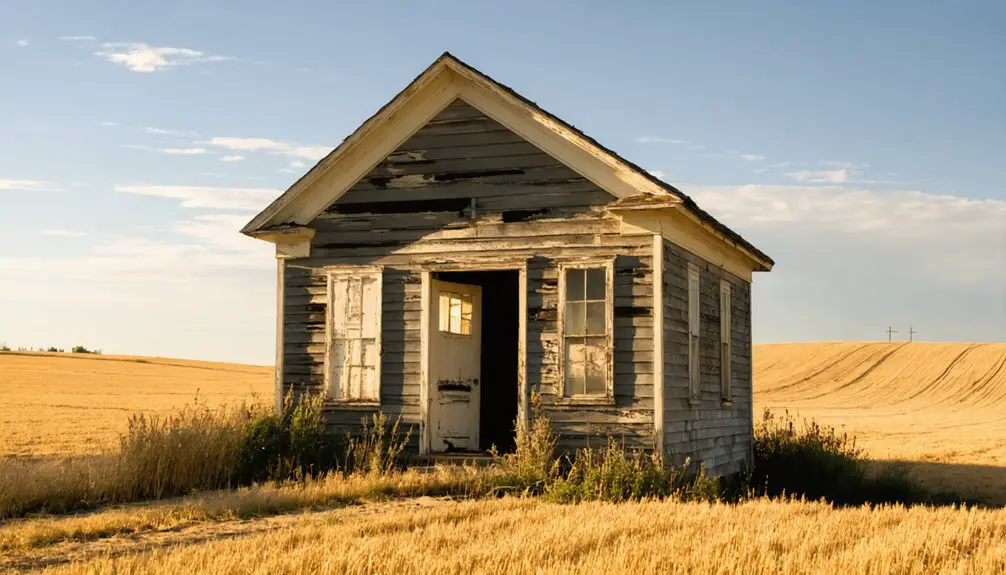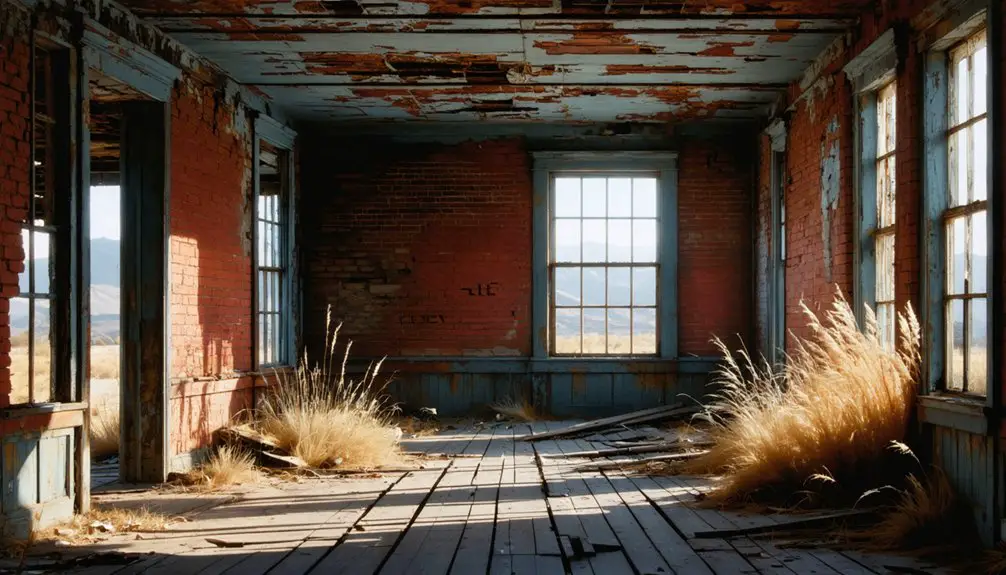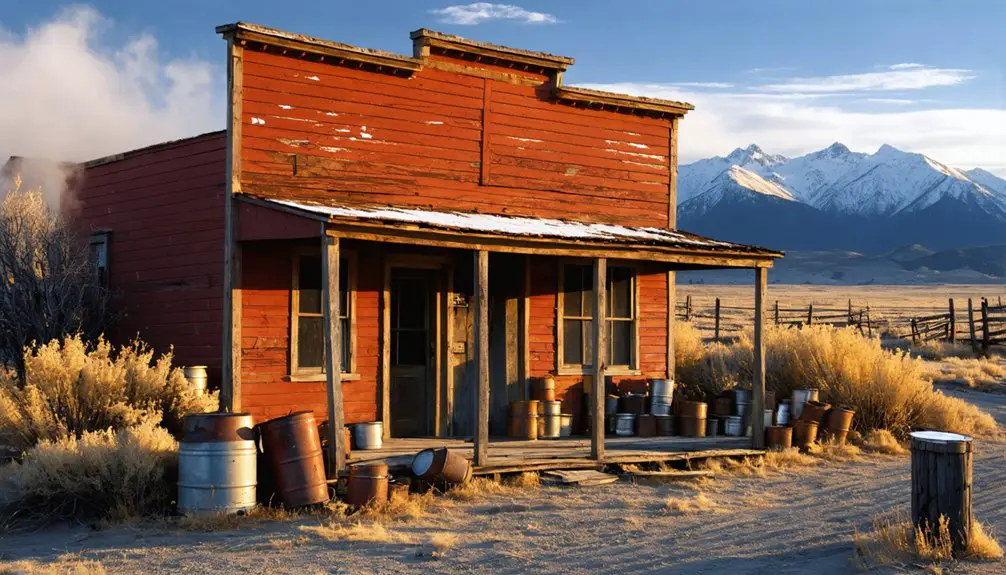You’ll find Orient, Washington tucked along the Kettle River, where gold fever transformed a miners’ camp into a thriving town of 450 residents by 1910. The First Thought Mine and Never Tell Mine anchored Orient’s economy, while its Main Street boasted a bank, school, and bustling businesses. When precious metal prices plummeted and rail service declined in the 1920s, Orient began its shift to ghost town status. The town’s preserved structures still whisper tales of frontier dreams.
Key Takeaways
- Founded in 1902 during a gold rush, Orient thrived as a mining town with a peak population of 450 by 1910.
- The First Thought Mine was crucial to Orient’s success, producing $180,000 in ore by 1905.
- Main Street once featured a bank, grocery store, and post office before economic decline led to business closures.
- The town declined after falling gold prices and reduced rail service in the 1920s transformed it into a ghost town.
- Historic structures still standing include the 1910 Orient Schoolhouse, City Hall, and PowerHouse foundations.
The Birth of a Mining Frontier
While prospectors had long worked the river bars of northeastern Washington, Orient’s true genesis came in 1902 when the Orient Improvement Company established a formal settlement.
You’ll find the town’s origins rooted in the mining techniques of Oriental miners who first worked these lands, leading to the area’s eventual naming.
The story really took off when three prospectors – Maloney, Morri, and Dunkle – struck it rich at the Never Tell Mine using traditional prospecting methods.
Their discovery of free-milling gold ore sparked a rush that would transform this temporary miners’ camp into a proper town.
The boom was so promising that locals believed Orient would surpass Republic as the region’s premier mining destination.
Within months, multiple mines were churning out precious metals, establishing Orient as a serious contender in Washington’s mining frontier. The First Thought Mine quickly emerged as a leading producer, generating $180,000 in ore by 1905.
Transportation infrastructure expanded to serve the growing community, including a 180-foot steel bridge spanning the Kettle River in 1909.
Golden Years Along Kettle River
As Orient entered its golden age in the early 1900s, the First Thought Mine emerged as the town’s crown jewel, producing an astounding $180,000 in gold ore by 1905.
Gold discoveries in the Kettle River Range sparked a rush that would make this region Washington’s most productive gold district of the early 20th century.
The Kettle River Range gold rush unleashed Washington’s richest mining district, forever changing the economic landscape of the early 1900s.
You’d have found miners employing various mining techniques throughout the range, working both 164 lode mines and placer deposits rich in gold, silver, copper, and other valuable metals.
The nearby Colville Indian Reservation saw significant land disputes as the mining boom attracted more settlers to the area.
By 1910, Orient’s success had transformed it into a proper town with its own bank, school, newspaper, and bustling Main Street.
The First Thought Mine continued operations until 1910, later reopening during the 1930s gold price surge, and ultimately yielded $885,000 in precious metals at historic prices.
Daily Life in Early Orient
When Orient blossomed into a proper town by 1910, daily life centered around its bustling Main Street where you’d find the Orient State Bank, Norton’s grocery store, and the local post office. Like The Count of Monte Cristo, the town’s story was one of transformation and rebirth.
You’d send your children to one of Washington’s oldest operating schoolhouses while joining your neighbors at community gatherings in the town hall. The town’s Asian miners had originally inspired its name.
With only two telephones in town, you’d take turns manning the phones, especially during WWII when the hall doubled as a Civil Air Patrol post.
- The rhythmic clanking of the 12,880-foot tramline reminded you of the town’s lifeblood – the gold and silver mines
- Your children’s laughter echoed through the schoolhouse, a symbol of the town’s permanent roots
- You’d share news and stories at Norton’s store, where everyone knew your name
From Boom to Bust: The Economic Shift
You’ll find Orient’s economic trajectory closely tied to the success of its mines, particularly the First Thought Mine which generated an impressive $180,000 by 1905.
Like many mining communities of that era, the population consisted primarily of hardworking immigrants and miners from Wales, England, Ireland, Italy, and Scotland.
The town’s rapid growth saw the establishment of critical infrastructure including the Orient State Bank, schools, and numerous businesses along the main street, all supported by the mining industry’s prosperity.
Transport solutions like the 1.5-mile tramline to the railhead enabled efficient ore shipment to smelters in Washington and British Columbia, cementing Orient’s position as a promising mining camp that briefly rivaled Republic.
Mining Prosperity Rises
The discovery of the Never Tell Mine by prospectors Maloney, Morri, and Dunkle sparked Orient’s remarkable transformation from a quiet frontier settlement into Ferry County’s most promising mining camp.
Mr. Moorehouse established a store and post office that served as a vital hub for the community until devastating floods destroyed the buildings.
The First Thought Mine led the region’s prosperity, extracting 45,000 tons of precious ore while pioneering mining techniques that set industry standards.
You’ll find the town’s rich miner culture reflected in the bustling infrastructure that quickly emerged, including the Orient State Bank, a school, and a thriving business district.
- Feel the rush of excitement as Orient’s streets filled with prospectors chasing their dreams of striking it rich
- Experience the pride of a community that built itself from the ground up, rivaling even Republic’s prominence
- Witness the spirit of determination as miners extracted gold at 0.18 ounces per ton, forging their own destiny
Market Forces Take Hold
Despite Orient’s meteoric rise as a mining powerhouse, plummeting silver and gold prices in the early 20th century dealt a crushing blow to the town’s economic foundation.
You’ll see how market dynamics ravaged this once-thriving community, as businesses along Main Street shuttered one by one. Similar to how today’s major retail chains are abandoning downtown areas across America, reflecting broader economic fragility.
Like many mining towns of the era, Orient’s lack of economic resilience proved fatal. The town’s singular dependence on mineral extraction left it vulnerable to the whims of commodity prices and shifting market forces. The story echoes through time, as seen in places like Marianna where the mine closure in 1988 triggered immediate community devastation.
Preserving Orient’s Legacy

You’ll find Orient’s story preserved through meticulous historical documentation, including photographs of the old post office and detailed records of the Never Tell Mine’s discovery by prospectors Maloney, Morri, and Dunkle.
While many original structures along Orient’s main street have vanished, community efforts focus on protecting the remaining buildings, particularly the historic schoolhouse that stands as one of Washington’s oldest.
Your support of local preservation projects can help safeguard Orient’s mining heritage through initiatives like educational outreach programs and partnerships with historical societies.
Historical Documentation Efforts
Through dedicated preservation efforts spanning decades, Orient’s rich history lives on in carefully curated collections of documents, photographs, and artifacts.
You’ll find a wealth of historical artifacts meticulously preserved in local museums, from mining tools to personal belongings that tell the story of daily life. The town’s legacy continues through archival preservation of land deeds, newspapers, and mining records that paint a vivid picture of its boom-and-bust journey.
- Walk the same dirt paths where miners once rushed to stake their claims, now preserved as tangible connections to the past
- Explore digitized photographs revealing the transformation from bustling boomtown to silent ghost town
- Discover personal stories through oral histories that capture the spirit of community resilience
Community Preservation Projects
Orient’s community preservation projects represent a dynamic fusion of architectural restoration and cultural storytelling.
You’ll find local enthusiasts working tirelessly to stabilize and restore key historic structures, including the iconic First Thought Mine, which stands as a symbol of the town’s mining heritage.
Through community engagement, these preservation efforts extend beyond physical restoration to embrace digital platforms and storytelling initiatives.
You can now experience Orient’s history through social media channels, podcasts, and guided tours that bring the past to life.
Local historians and volunteers have transformed historic buildings into interpretive spaces and community facilities, ensuring these landmarks remain functional while preserving their historical significance.
They’ve installed educational signage and created displays that help you understand the economic and cultural forces that shaped this remarkable mining community.
Railroad’s Role in Orient’s Story
When the first railroad franchises were granted in Ferry County in 1889, few could have predicted the fierce competition that would shape Orient’s destiny.
The battle between Great Northern Railway and the Republic and Kettle River Railroad sparked intense railroad competition that would transform this remote wilderness into a bustling frontier town.
You’ll find Orient’s story intertwined with the railroads that brought economic development, connecting the area’s rich mineral deposits to distant markets.
- The dramatic race between rival rail companies to reach local gold fields shaped Orient’s very location along the Kettle River.
- Orient’s population surged to 450 by 1910 as rail access opened opportunities in mining, timber, and farming.
- The decline of rail service by the 1920s marked the beginning of Orient’s shift to ghost town status.
Notable Structures and Landmarks

Standing as silent witnesses to Orient’s vibrant past, the town’s remaining structures tell compelling stories of community life, civic pride, and industrial innovation.
You’ll find the 1910 Orient Schoolhouse, considered by many to be Washington’s oldest operating schoolhouse, displaying its architectural significance through period windows and original design elements.
The historic City Hall and abandoned post office showcase the town’s former civic significance, while the 1947 First Thought Mountain Lookout offers panoramic views of the surrounding landscape.
Perhaps most intriguing are the PowerHouse foundations and unique water trestle system, which represent the community symbolism of Orient’s industrial heritage.
Each structure provides a tangible connection to the town’s mining era, preserving memories of a once-thriving community.
Orient’s Place in Washington History
Emerging from the rugged landscapes of northeastern Washington in 1902, the mining town of Orient carved its place in state history through a compelling story of discovery, prosperity, and eventual decline.
You’ll find Orient’s cultural influences woven into Ferry County’s development, from its Asian mining heritage to its role in wartime civil defense. The town’s mining innovations and economic impact made it one of the region’s largest settlements, rivaling Republic during the early 1900s.
- Your visit today reveals a poignant reflection of the American West’s boom-and-bust legacy
- You’re walking the same grounds where determined miners once extracted $180,000 in gold ore by 1905
- You’ll discover how Orient’s story mirrors countless Western mining communities that shaped America’s resource frontier
Frequently Asked Questions
What Happened to the Original Never Tell Mine Site?
Like a fading ghost, the original Never Tell Mine site has vanished from the landscape. You’ll find hardly any trace of its mining infrastructure, as it’s been reduced to empty terrain.
Are Any Descendants of the Three Founding Prospectors Still Living Nearby?
You won’t find documented historical connections showing descendants still living nearby. While family legacy research might reveal answers, there’s no clear evidence of Maloney, Morri, or Dunkle’s families in the area.
What Was the Total Population of Orient at Its Peak?
You’ll find that Orient’s exact peak population isn’t documented, but given its historical significance as Ferry County’s greatest mining camp, estimates suggest between several hundred to low thousands during the 1900s boom.
Can Visitors Still Pan for Gold in the Kettle River Today?
Picture yourself sifting through the sparkling waters – you can try gold panning in the Kettle River where it’s open land, but you’ll need to verify current claims and land status first.
Were There Any Major Crimes or Notorious Incidents During Orient’s Boom Years?
You won’t find records of major crimes or notorious figures during Orient’s boom years. Unlike some wild mining towns, historical documents suggest it maintained a relatively peaceful, orderly community atmosphere.
References
- http://www.ghosttownsusa.com/orient.htm
- https://orientsd.org/wp-content/uploads/2013/06/Stories-of-Old-Orient.pdf
- https://aullori.wordpress.com/2006/10/28/orient-washington/
- https://www.youtube.com/watch?v=0JLTapdmaYY
- https://stateofwatourism.com/ghost-towns-of-washington-state/
- https://www.dnr.wa.gov/Publications/ger_ofr2004-18_iaml_talisman.pdf
- https://revisitwa.org/waypoint/orient/
- https://www.dnr.wa.gov/Publications/ger_ic103_iaml_firstthought.pdf
- https://www.discoverdarrington.com/history-2/history-of-the-mountain-loop-highway/
- https://en.wikipedia.org/wiki/Kettle_River_Range



